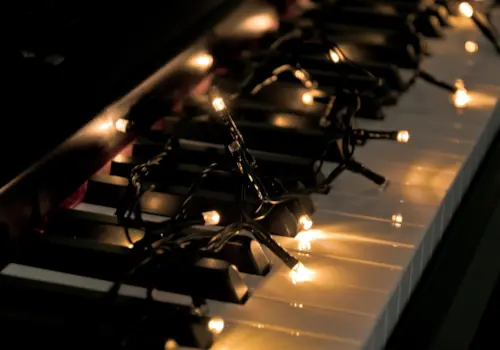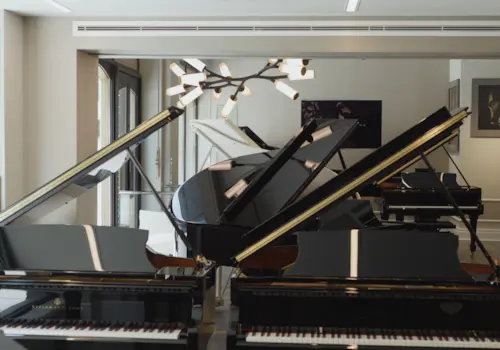We spoke to a few different makers and suppliers and asked for their opinion on what a customer needs to be wary of when purchasing a used piano
There are a lot of benefits to buying a used piano instead of a brand-new piano – not least the money-saving aspect of it.
However, because the piano is no longer new, it’s more important than ever that you make sure you are truly getting a good quality piano. It may be cheaper, but you are still making a sizeable investment. The last thing you want is to be sold a piano with lots of underlying issues.
We spoke to a few different makers and suppliers and asked for their professional opinion on what a customer needs to be wary of when purchasing a used piano. Let’s take a look…
Check the casework

Damaged casing. © Stack Exchange
We start with the part of the piano that is last to be fitted but first to be noticed by a buyer; the casework.
Before we even sit down to buy a piano, we are influenced by the way it looks from the outside. Do we like the colour? The details? The material? Are there any knocks or scratches?
These are all things we can see with the human eye, but there are more intricate things to look out for when it comes to the casework. Simon Markson, managing director of piano dealer Markson Pianos, gives some crucial advice on how to assess the quality of a used piano’s casework:
“The acoustic piano is essentially a box of tricks and a Pandora’s box if you are not careful to appraise its contents.
The casework is the last to be fitted and the first to be noticed. Natural wood finishes can fade in direct sunlight and this is not easily remedied. Also look for knocks and superficial scratch marks that can be repaired. Stripping and re-polishing is sometimes necessary for older pianos and when an invisible repair and perfect finish is required for a polyester finish.”
Give the key action a good check-over

An example of uneven keys. © David Boyce
The condition of the keys is perhaps the most important aspect when looking for a used part. After all, it's the part of the piano you will be spending the majority of your time on. Millers Music has provided three great and easy-to-remember tips on what to look out for:
✔ The response of the keys
“Do they all go down smoothly and come back up promptly? Keys that don’t return could be jammed, have broken action parts, or might be rubbing against each other.”
✔ The evenness of the keys
“It’s good practice to squat down in front of the keybed to see if any are higher or lower than the rest. Whilst slightly uneven keys may be a sign of general wear, heavily uneven keys across the keybed could be a sign of moth damage to the cloth and felt of the piano, including the hammers. These will all require a technician’s hands to fix.”
✔ The colour of the keys
“They should be near brilliant black and white!”
What if the key action isn’t in good condition?
There are ways that you can improve the condition of a piano’s key action if you want to put the work in yourself. Here’s Simon Markson’s advice:
“Often some basic regulation work to the piano action is all that is necessary, including easing of keys and spacing of hammers.
However, more extensive work might entail a comprehensive overhaul and this would include dismantling the piano action. There is a long list of component parts that might need to be cleaned or replaced including felts, hammers, springs and centre pins.
The most important and crucial pins are however the tuning pins that hold the strings and determine the string tension. These should be tested by a tuner to make sure that the pins hold tight and will not slip. Replacing tuning pins and perhaps the wrest plank which hold the pins itself is a costly expense and often not cost effective.”
You may be better off searching for a different piano if you feel unable to put the money and time into fixing the action yourself.
Make sure the soundboard is in good condition

A grand piano soundboard
If it’s an upright or grand piano that you are checking out, make sure to give its soundboard a good look over.
On an upright, this will be located in the large space underneath the keys and above the pedals. You will need to remove the outer piece of wood in order to give the soundboard a good check. Ask for help with this.
On a grand, the soundboard is located under the piano lid. Again, ask for help when lifting the lid as to not damage the piano.
Simon Markson advises that you look for possible splits often caused by the moisture drying out from the effects of central heating. “A piano is after all and relatively speaking a living, breathing material. Cherish it and it may last for generations,” he comments.
Ask a trained piano tuner to assess the instrument before purchasing

Whilst the advice in this article will go some way to helping you find a good quality used piano, it’s always useful to get the opinion of a professional. They will be able to give advice on things you’ve already noticed, and even pick up on other issues you haven’t yet seen. This is a piece of advice that piano giant Kawai stands by.
“They will be able to advise on the condition of the instrument and any potential issues it may face in future, as well as the cost of potential repair,” says Kawai.
Give the piano a test drive before committing

This seems an obvious one, but it’s amazing just how many customers buy a piano without even first giving it a test drive. “Every single piano is made of individual pieces of organic material – mostly wood with their own grain patterns and characteristics,” says Kawai. “These can lead to subtle differences in character. However, as a piano’s sound is so dependent on these materials, it is important to note that one piano may sound slightly different to another of the same model.”
In essence, if you find and play a piano you like, make sure you secure that EXACT piano!










